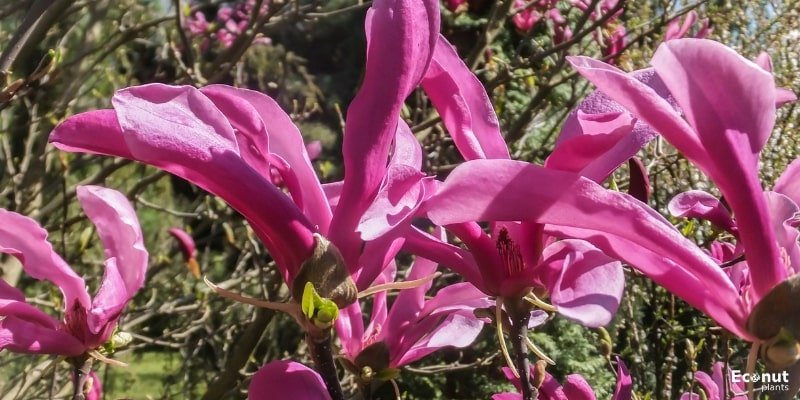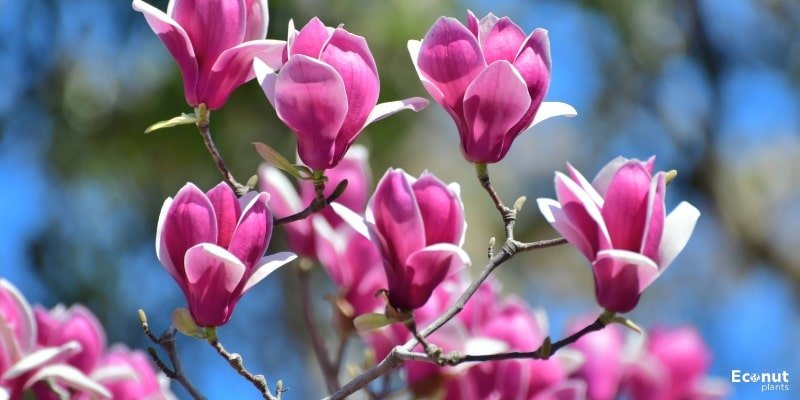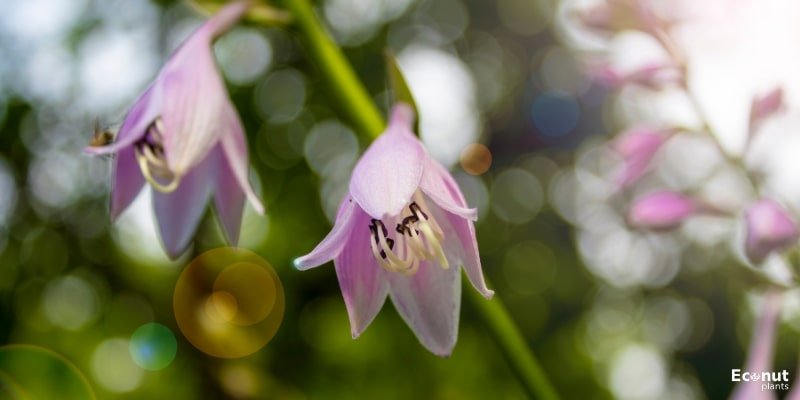Are you looking to add a pink-blossomed magnolia tree to your home’s landscaping or garden? Beautiful pink blossoms can be found on a variety of Magnolia tree species. In this article Includes pink-flowering magnolia trees.
1. Daybreak

Scientific Name: Magnolia ‘Daybreak’
Bloom Time: Late Spring
Plant Size: 20-40 tall
Light: Full Sun to Part Shade
Unlike most magnolia trees, Daybreak has a columnar growth habit. The majority of magnolias have a spread that is comparable to their height. Daybreak becomes noticeably taller than it is wide. Since it is a late-blooming cultivar, frost usually doesn’t harm its blossoms.
The tree is bearing enormous, pastel pink blooms, with pale-yellow stamens that are dusted with pink and have a white inside, and deep pink carpels.
This sweet-smelling magnolia has won a Gold Medal from the Pennsylvania Horticultural Society and another Award of Garden Merit from the Royal Horticultural Society. It can withstand pollutants, thrive in urban environments, and adjust well too many soil types.
2. Pinkie

Scientific Name: Magnolia x ‘Pinkie’
Bloom Time: Late Spring
Plant Size: 10-15 tall
Light: Full Sun
Another little girl from the National Arboretum is called “Pinkie.” This delightful hybrid will withstand most frosts because it was designed to bloom later than most saucer magnolias, yet a late frost can still harm the blossoms.
This modest-growing kind can be planted as a small tree or shrub. It thrives in urban environments and is tolerant of most types of soil. In April, it creates a magnificent focal point.
For such a little type of tree, the blooms are rather enormous (7″–8″). The tips of the outer petals, which are pale pink in colour, fade from reddish-purple. The petals have a gentle pink glow due to the exterior colour showing through the white within. Pink stamens surround a yellow-green eye on all sides.
3. Leonard Messel

Scientific Name: Magnolia x loebneri ‘Leonard Messel’
Bloom Time: Spring
Plant Size: 15-30 tall
Light: Full Sun
This cultivar produces beautiful bi-colour flowers at a young age. The creamy white interior of the petals is softly blushed to match the rosy, purple exterior. When blossoms appear on bare branches, this combination of colours gives the entire tree an exquisite pink impression.
This cultivar is tiny and creates a really pretty miniature tree. It can also be trained into the shape of a shrub by keeping it low. When it produces its profuse, star-shaped blooms, this beauty is a sight to behold, no matter what form you train it to take.
4. Ballerina

Scientific Name: Magnolia x loebneri ‘Ballerina’
Bloom Time: Spring
Plant Size: 20 tall
Light: Full to Part Sun
This elegant species provides a quick payback for the time spent caring for it. Ballerina flowers early and abundantly, despite having a slow growth rate. The blooms are gorgeous, primarily white with a blush pink centre and a delicate yellow eye. The flowers are aromatic and medium-sized (4’–6′), with at least 30 petals arranged in a star pattern. Additionally, the flowers make beautiful cut flowers.
A ballerina can live up to 80 years and grow at a medium rate. Although it is not a large tree, its amazing dome-shaped habit makes it a magnificent focal point in the landscape come springtime.
The ideal soil for this species is wet and well-drained. Ballerina struggles in cities because it is intolerant of urban pollution. At her core, this dancer is a country girl.
5. Gracilis

Scientific Name: Magnolia liliiflora ‘Gracilis’
Bloom Time: Late Spring
Plant Size: 12 tall
Light: Full Sun to Part Shade
Gracilis, a plant that is well-known for growing in Asian temple gardens, was brought over from Japan in 1804. This type typically spreads more widely and at a modest rate. Its appearance is greatly enhanced by the spread, which is often wider than tall.
Purple buds on Gracilis open to reveal 3″–4″ pink lily-shaped blooms. This cultivar has a shrubby form and is tiny and hardy. It appears slim and graceful, both in its branches and blossoms. The blossoms have a delicate appearance and don’t smell particularly strong.
6. Jane Platt

Scientific Name: Magnolia stellata ‘Jane Platt’
Bloom Time: Spring
Plant Size: 10-15 tall
Light: Full Sun to Part Shade
“Jane Platt” is a little cultivar that resembles a shrub rather than a tree. Its amazing blossoms continue to make it much sought-after despite this. Jane has abundant, star-shaped double flowers. The smaller (4′) blossoms have up to 32 petals apiece and are fragrant and delicate pink in colour.
Early spring brings an abundance of these beautiful blooms on bare branches, creating the ideal blank canvas for these bursts of rose deliciousness. This species from Oregon makes a beautiful focal point for the spring garden.
7. Black Tulip

Scientific Name: Magnolia x soulangeana ‘Jurmag1’
Bloom Time: Early Spring
Plant Size: 15-20 tall
Light: Full Sun
Though the Black Tulip tree’s blossoms are more burgundy in colour than genuine pink, they are nevertheless so exquisite that they should be included on any list of magnolia plants. Vibrant, deep magenta, 6-inch tulip-shaped flowers. The massive, weighty blooms first appear in the spring, although in certain milder regions, they could reappear in the middle of summer.
This eye-catching little tree thrives in city yards. It can grow in a variety of soil types, but it needs good drainage to do so. It grows in a modest manner, and its beautiful blossoms are robust and long-lasting. Bring these flowers inside, or at least make sure you can see them from your most noticeable window.
8. Alexandrina

Scientific ame: Magnolia x soulangeana ‘Alexandrina’
Bloom Time: Spring
Plant Size: 20-25
Light: Full Sun
The saucer-magnolia variation Alexandrina has big, fragrant, light pink blooms that range in width from 6″ to 10″. The buds open to a much gentler shade of blush pink that fades to white at the edges after appearing as pale purple in late winter. These are an amazing feast for pollinators because of their aroma and copious amounts of pollen.
This variety’s rounded, symmetrical growth habit makes it ideal for a big shrub or privacy hedge. By pruning the lower branches, you can make a beautiful little to medium-sized tree. Because Alexandrina requires some shelter from frost, it’s a good idea to plant it next to a house or other building.
This adds to the advantage of being able to see and smell it as much as possible. It grows best in broad sun and with even moisture on Alexandrina.
9. Caerhays Belle

Scientific Name: Magnolia ‘Caerhays Belle’
Bloom Time: Spring
Plant Size: 20-40 tall
Light: Full Sun to Dappled Sun
This variety, which was produced in 1951 at Caerhays Castle in England, is one of the most spectacular flowering trees I have ever seen. It first blossomed there in 1965. Since caerhays require 20 years to reach maturity when planted from seed, grafting is typically used to propagate them.
This gorgeous plant blooms profusely in mid- to late-spring with extra-large (12″), vivid pink, goblet-shaped blooms. Given that it blooms early, a late frost may have detrimental effects. A very striking and magnificent tree, Caerhays can reach a height of 50 feet.
2012 saw it win the Garden Merit Award from the Royal Horticultural Society. A queen would be proud of this type of magnolia. My recommendation is to get a Caerhays Belle magnolia if you have enough room for a really huge tree.
10. Lilliputian

Scientific Name: Magnolia x soulangeana ‘Lilliputian’
Bloom Time: Spring
Plant Size: 12 tall
Light: Full Sun to Part Shade
This variety of saucer magnolia is small, as its name implies. However, as any admirer of Gulliver’s Travels is aware, its spirit more than makes up for its lack of grandeur. “Lilliputian” is charming and small. Because of its size, it works well in both larger containers and more space-constrained environments.
Gorgeous tulip-to-saucer-shaped blossoms perfectly match this tree’s amazing structure. Inside, the flowers are white, but from the base to the tips of the outer petals, they have a lovely rose tint. They make wonderful cut flowers and smell lightly like lemon.
11. Betty

Scientific Name: Magnolia x ‘Betty’
Bloom Time: Mid Spring and into summer
Plant Size: 10-15
Light: Full Sun
Betty belongs to the group of hybrids known as “Little Girls” at the U.S. National Arboretum. It grows in an erect, rounded manner, reaching a maximum height of around 15 feet. It looks great when arranged along a border or as the main attraction. Because of its sluggish growth pattern, this magnolia can also be cultivated in containers.
The fragrant flowers of Betty have a big diameter of 8″. This cultivar protects itself from late frost damage by blooming in the middle of spring and intermittently during the summer. Betty is resilient.
Nearly every stem tip ends in pink, tulip-shaped blooms that bloom from her reddish-purple buds. Although this type is simple to grow and can withstand moderate shade, full light is ideal for blooming.
Conclusion
This is but a small selection of the several pink-blooming magnolia cultivars available. These gorgeous trees and shrubs are great year-round complements to any landscape, but they’re even more breathtaking to see in the spring when they bloom.
There are numerous sizes, forms, and colours of magnolias. Their broad green leaves make for a magnificent, shaded backdrop in the summer, and their fragrant blossoms and gorgeous, dense foliage draw in plenty of birds and pollinators.

